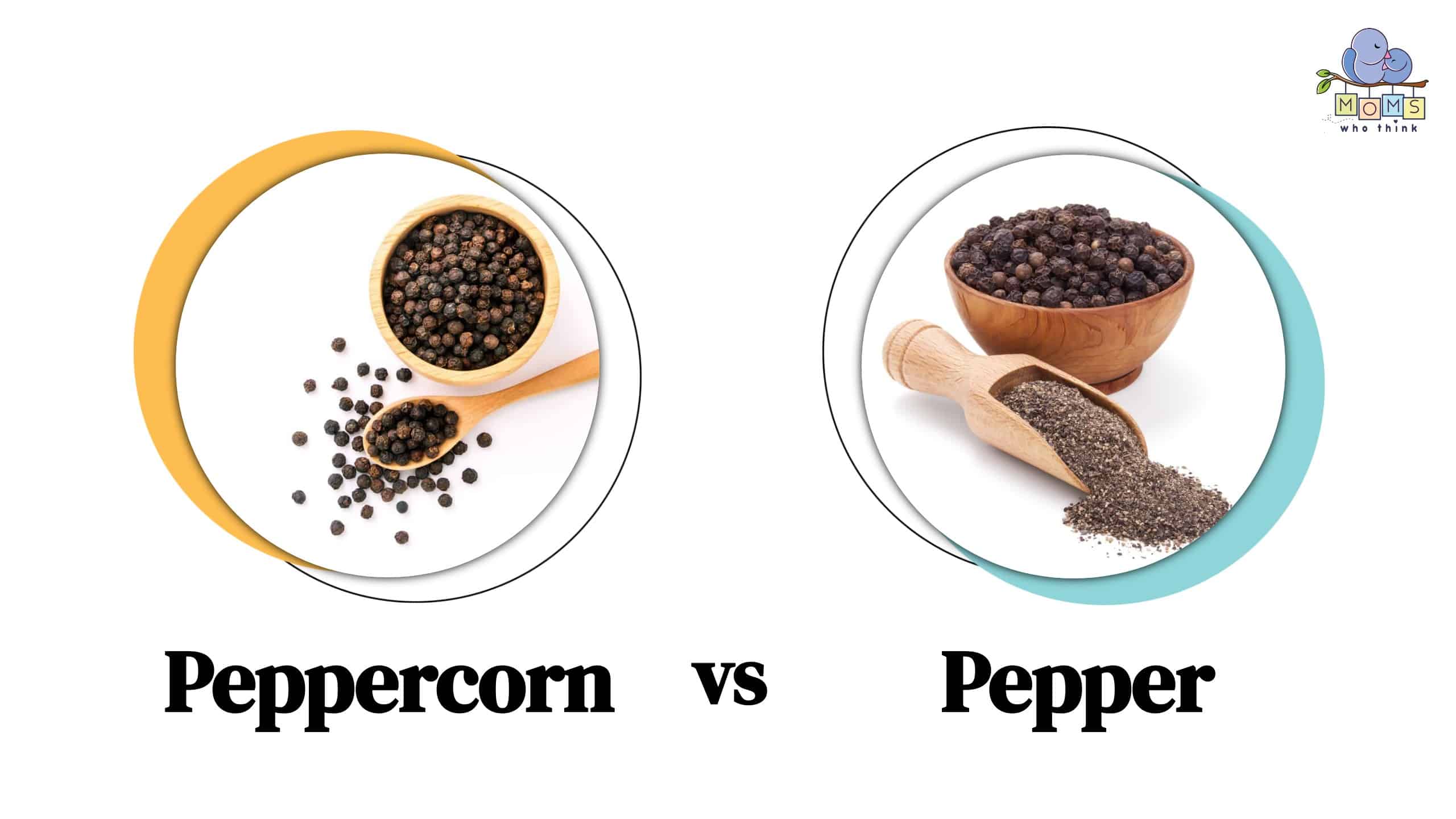Across the world, in almost every pantry, two specific spices reign supreme: salt and pepper. When families sit down for dinner, two shakers will typically sit with them. You know these spices add flavor and heat to our meals, but do you ever consider how they get there? You may have heard of the word peppercorn in conjunction with pepper. However, what exactly is peppercorn? More importantly, what is the difference between peppercorn and pepper?
This article will go into more detail about the differences below. However, the main difference lies in the processing methods of the two. Peppercorn is the dried-up berry of a vine, piper nigrum, and pepper is the ground version of a black peppercorn. Peppercorn and black pepper have both been around since ancient times. Their history is rich and long, dating back to trading because many highly desired this spice.

Salt and pepper are the king and queen of spices. It's common to find shakers of both of these spices in almost every home. They are simple yet powerful at bringing a meal to life.
©PV productions/Shutterstock.com
Peppercorn vs. Pepper: What are the Differences?
There are a couple of differences between peppercorn and pepper. First, peppercorn is whole berries that dry in the sun. They produce an intense flavor and wrinkly appearance. Pepper is simply black peppercorn that has been ground.
Both peppercorn and pepper are excellent spices for seasoning many types of meals across the board. Ground pepper makes the process simple by producing a ground spice that quickly melts into the meals while still giving off the same strong and spicy flavor.
Although peppercorn and pepper derive from the same berry, some key differences exist. We will explore these fundamental differences below.
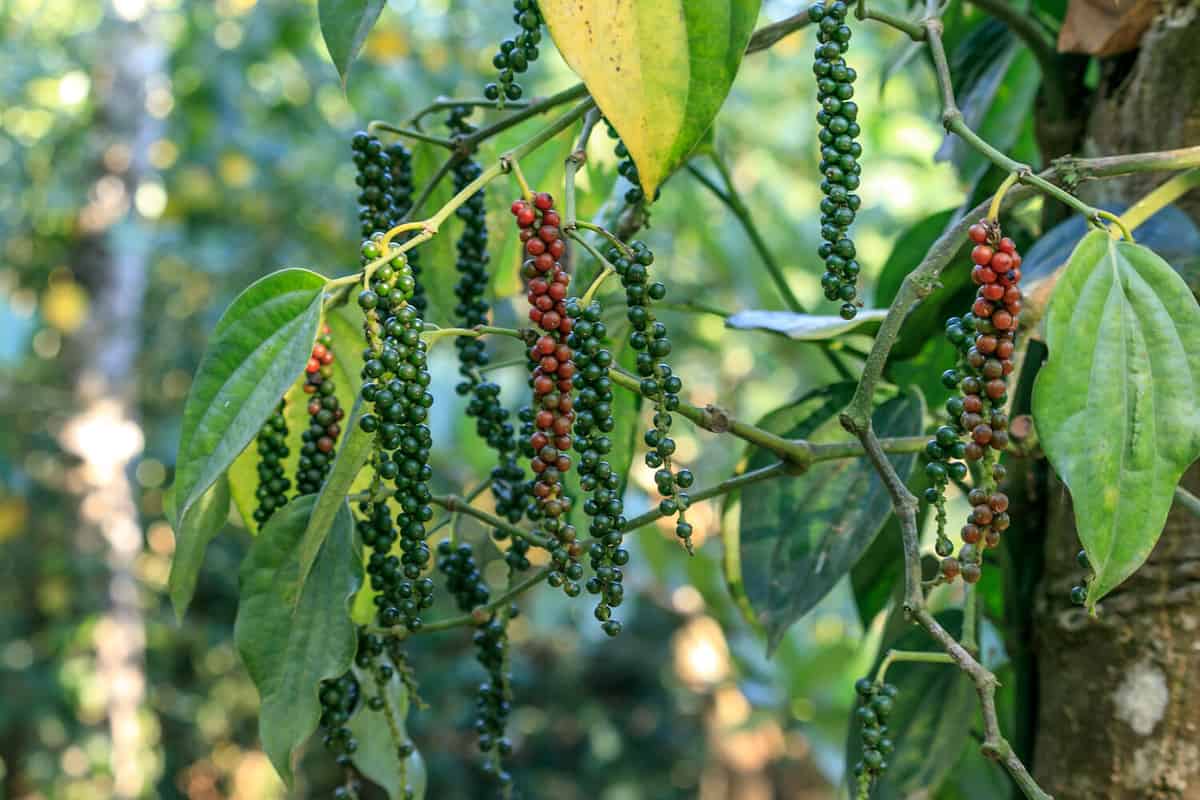
Peppercorns grow on a vine in Southeast Asia and the Indian subcontinent. Vietnam is the lead producer of peppercorn worldwide.
©Wirestock Creators/Shutterstock.com
Texture and Flavor
The first key difference we will explore is the texture and flavor of peppercorn and pepper. Technically, the flavor of pepper and peppercorn are very similar. They both give an intense and zesty undertone. This spicey taste comes from peperine. Peperine can stimulate our taste buds, which in turn increases our saliva.
The texture of a peppercorn is wrinkly with rough outer skin. On the other hand, pepper has been ground to the point where the texture is very subtle. The subtle texture of ground pepper makes it excellent for daily meal preparation and a fantastic spice for almost any dinner.
What are the Different Processing Methods?
Peppercorn has a few different processing methods that the berries undergo. The specific processing method will determine which color each peppercorn is. Peppercorn has various coloring variations, including black, green, white, and red.
Black peppercorn cooks and then dries, leading to a wrinkled and dry black peppercorn. Black peppercorn is the base of black pepper. It undergoes more processing after the black peppercorn dries to produce black peppercorn. The processing includes grounding the peppercorn, which gives us the popular ground black pepper we enjoy on our dinner tables.
Peppercorn vs. Pepper Nutritional Value
Peppercorn and black pepper offer many nutritional benefits. For starters, pepper carries antioxidants that can lower the chance of chronic disease, including cardiovascular disease. Pepper also helps your body absorb nutrients into the bloodstream and supports immune health.
Aside from the benefits, there are also many nutrients that pepper has to offer. These include vitamins K, E, and A. Pepper also has vitamin B6, iron, Manganese, calcium, and potassium. Look at the comparison chart below to see how they stand against one another.
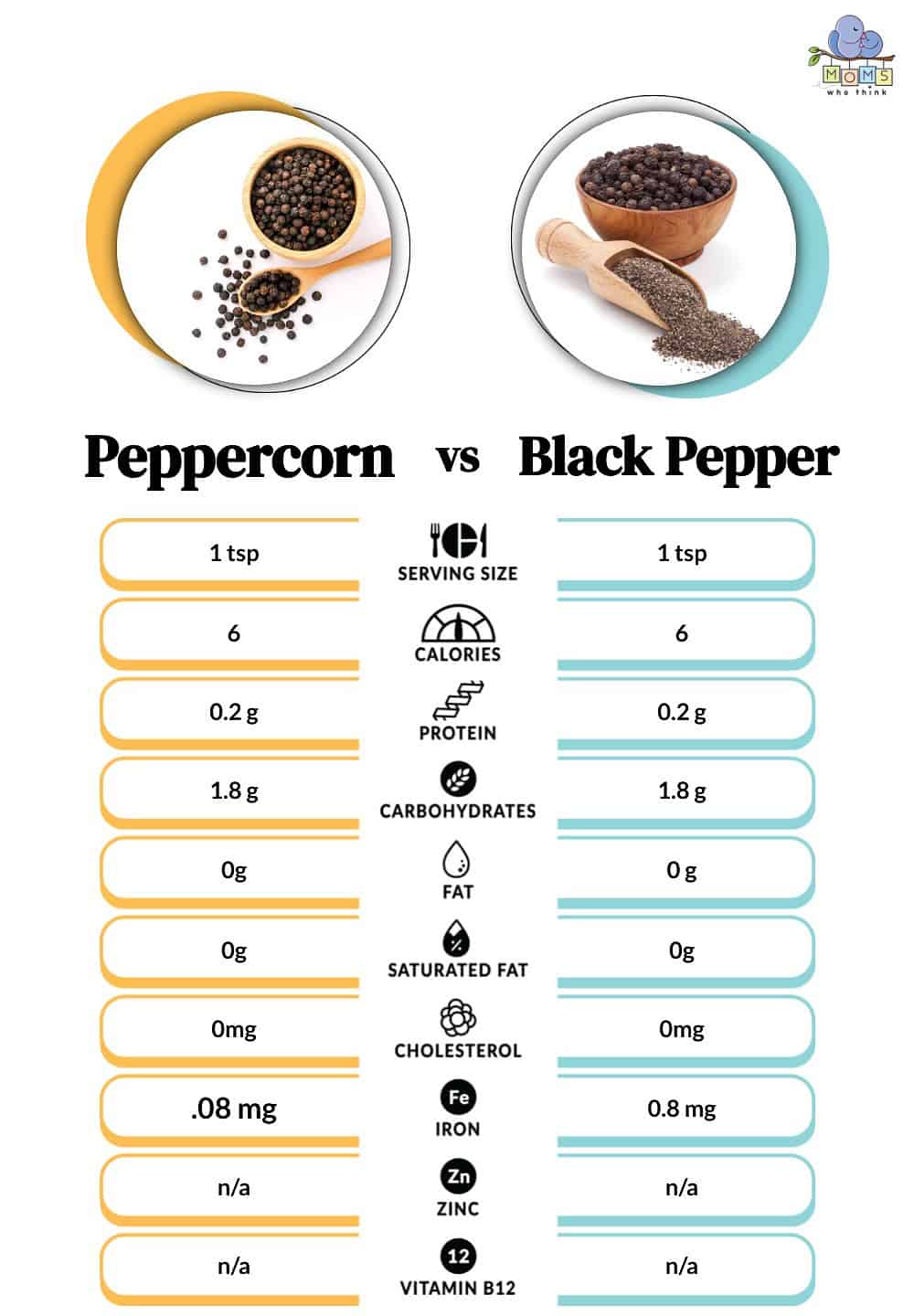
©
What is Peppercorn?
Peppercorn was once a luxury. Only the wealthy had access to it; now, it is a staple worldwide. It is excellent for seasoning almost every meal, as a preservative, and even adds heat to a dish.
Peppercorn is a dried-up berry that comes from the piper nigrum. Piper nigrum is a flowering vine found in Southeast Asia and Indian Subcontinent. The vine plant produces multicolored berries. These berries cook, dry out, and used for seasoning.
What Are The Different Types of Peppercorns?
If you have ever bought peppercorns, you will notice several different colors available. These colors depend on when the berries harvest from and how the processing methods.
The berries grow on a vine very similarly to grape bunches. The black peppercorn is the peppercorn that black pepper comes from. The berries start as the green peppercorn picked off the vine. They then cook and sun-dry- The enzymes in the skin turn the outer layer almost black while it dries. The skin also becomes wrinkly.
Green peppercorn does not cook like black peppercorn. Instead, it gets treated with preservatives. This allows the peppercorn to keep the green color, meaning it doesn't have as long a shelf life as black peppercorn.
Next is a white peppercorn. White peppercorn is fully ripe. It starts as black but soaks to soften the outer layer. The outer layer is then peeled away, leaving the seed. Afterward, the white seed dries in the sun. This is where the white peppercorn comes from.
Red peppercorn does not soak. Instead, it is preserved, leaving the red color.
Peppercorn has been a popular commodity since ancient times. Black peppercorn has the spiciest flavor and was a popular seasoning to trade during the ancient civilizations. It was also used as a currency in Southeast Asia, and it has been said that it was once used in the mummification process in Ancient Egypt.
Another fun fact is that Vietnam is the world's top producer of peppercorns.
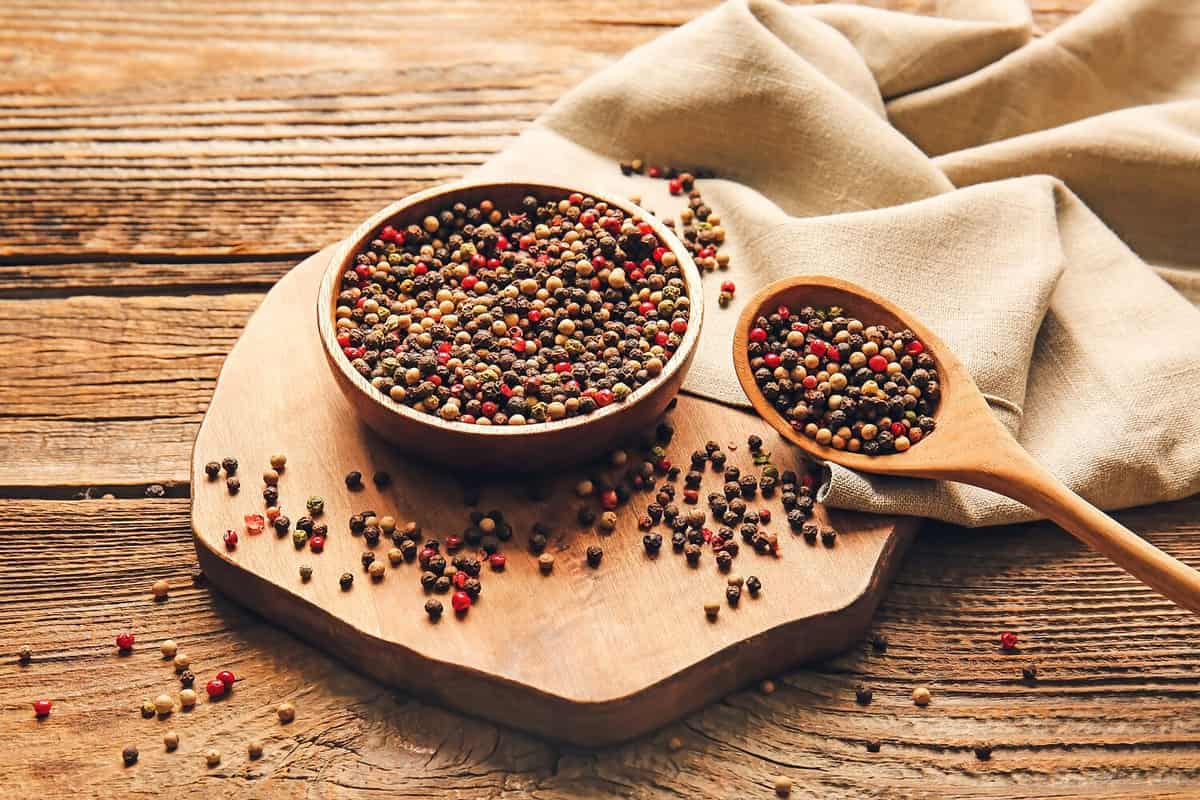
Different colors of peppercorns are available, from red and black to white and green. Black peppercorns are the spiciest and strongest of all the colors.
©Pixel-Shot/Shutterstock.com
What is Pepper?
Now on to pepper. Pepper is simply black peppercorn that has been ground up, making it easier to use as a spice in almost any dish.
Pepper has always been one of the most sought-after spices. Before the modern age, it was known as “black gold” and was only available to those who were very wealthy, much like sugar.
Pepper is a spice great for flavoring foods, adding heat, and as a preservative. Pepper also has a vast capacity for health benefits.
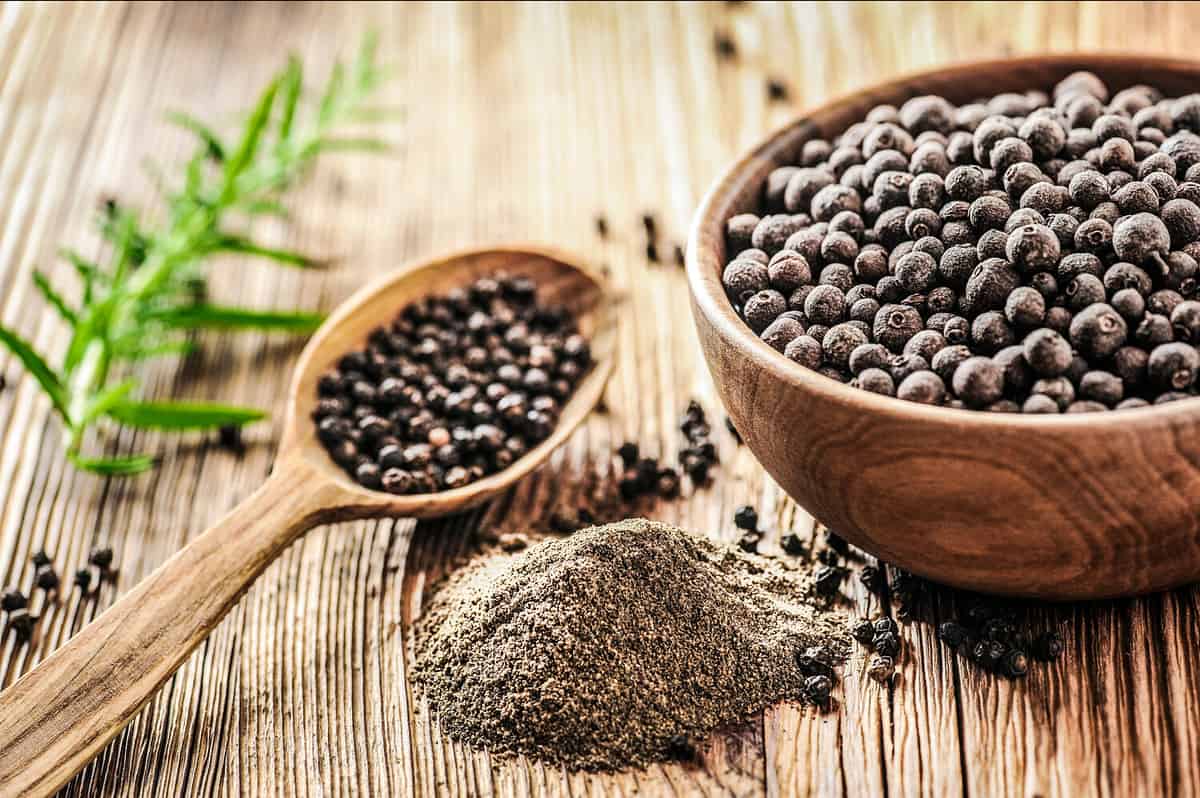
Black pepper is a common spice. It is simply the ground of black peppercorn. The fact that it is ground up makes adding to a variety of dishes easier.
©Krasula/Shutterstock.com
Can You Substitute Peppercorn for Pepper?
In short, yes. Peppercorn and pepper are virtually the same thing, simply in different forms. Interchanging these two forms of spices is possible.
However, it is important to remember that pepper has undergone more processing, meaning it loses flavor. Peppercorn gives a sharper and spicier flavor than ground pepper. You must adjust your spices accordingly if you want more or less heat. In addition, black pepper has a relatively shorter shelf life than peppercorns. This means pepper loses its flavor and spices faster than a peppercorn.
One Last Note
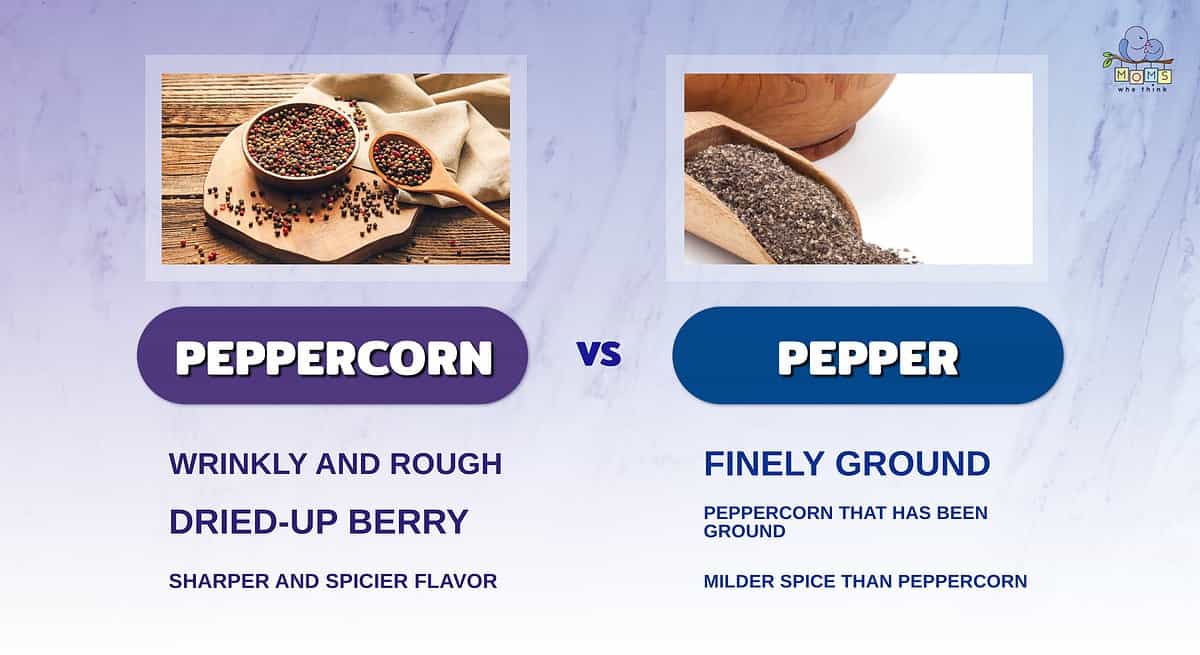
- Peppercorn has a wrinkly and rough exterior. Since it has been finely ground, the texture of pepper is very subtle. This is what makes it a popular inclusion in recipes.
- Pepper is just ground-up peppercorn. Peppercorn is a dried-up berry picked off of a vine.
- The taste of peppercorn is sharper and spicier than pepper. If you choose to use peppercorn instead of pepper in a recipe, make sure you keep this in mind.
Peppercorn has a long history of being a highly sought-after spice, considered a luxury for a long time. Now, we can access peppercorns and pepper by running to the grocery store. Peppercorn was once considered a luxury because it has incredible health benefits and is excellent at seasoning bland meals.
Regardless if you enjoy peppercorn in all its whole glory or prefer the ground-up version, there's no getting around it. Peppercorn and pepper are simple yet powerful seasonings that can bring your meal to life in a way you never thought possible.
Try this pork and pears in peppercorn sauce recipe:
Print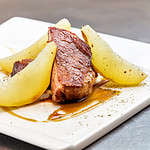
Pork and Pears in Peppercorn Sauce
- Yield: Serves 4
Ingredients
2 medium pears, cored and sliced
1 cup orange juice, plus more if necessary
1 tablespoon cooking oil
4 (3 ounces each) boneless pork loin chops, about 1 inch thick
1 tablespoon all-purpose flour
1 tablespoon Dijon mustard
1 teaspoon whole black peppercorns, crushed
1/4 teaspoon nutmeg
Instructions
1. In a medium saucepan, cook pear slices, covered, in orange juice for 5 to 7 minutes or until tender. Remove with a slotted spoon, reserving liquid. Cover pears; keep warm.
2. Measure liquid, and if necessary, add additional orange juice to equal 1 cup. Set liquid aside.
3. In a large skillet, heat cooking oil over medium-high heat. Add pork; reduce heat to medium.
4. Cook, uncovered, for 10 to 12 minutes or until no longer pink. Remove chops from skillet and keep warm, reserving the drippings in the skillet.
5. For the sauce, stir flour into the reserved drippings. Stir in the 1 cup reserved juice, mustard, peppercorns, and nutmeg. Cook and stir until thickened and bubbly. Cook and stir for 1 minute more.
6. To serve, place chops on individual plates, arrange pear slices on top, and spoon sauce on top.
Nutrition
- Serving Size: Per serving
- Calories: 231
- Sodium: 127mg
- Fat: 10g
- Saturated Fat: 2g
- Carbohydrates: 24g
- Fiber: 3g
- Protein: 13g
- Cholesterol: 38mg
Comparison Posts
- Chili Powder vs. Chili Flakes: How to Break Down Spices and Heat
- White Pepper vs. Black Pepper: Health Benefits and Uses
- Pizza Sauce vs. Marinara: Flavor, Texture, and Ingredient Differences
- Pasta Sauce vs. Marinara: How Different Can They Be?
- MSG vs. Salt: Chemical Differences, Popular Uses, And Health Considerations
- Crushed Red Pepper vs Red Pepper Flakes: Differences, Health Benefits, Processing
